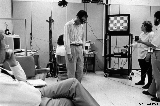


Parkinson's Project main page
Parkinson's Project
Many people with Parkinson's Disease experience progressively greater difficulty in initiating and sustaining walking, a condition known as akinesia. This disorder can be mitigated by treatment with drugs such a L-dopa, a chemical precursor of the natural neural transmitter dopamine, but usually not without unwanted side effects.
 View larger version of this image. |
Using Virtual Vision Sport eyewear, and other devices, an effect called kinesia paradoxa has been simulated, the triggering of normal, walking behavior in akinetic Parkinson's patients by the placement of physical obstacles at their feet. Near-normal walking can be elicited by presenting virtual objects and abstract visual cues moving through the patient's visual field at speeds that emulate normal walking.
The researchers have also discovered that appropriately placed laser spots can be used to trigger the response, but may not be a robust a solution for more severely akinetic patients. Laser cues may also be less viable under a variety of lighting conditions and patient activities.
The research team is currently identifying the most important design parameters of the physical display and dynamic graphics presented. Once these are determined, a device can be customized for this application, potentially allowing many Parkinson's patients to walk unassisted without medication, at least at some stages in the development of the progressive disorder.
The key collaborator and original subject on the project in podiatrist Tom Riess of San Anselmo, CA, who suggested the idea of using virtual imagery and has conducted much of the research on himself.
Contacts
Suzanne Weghorst <weghorst![]() u.washington.edu>
u.washington.edu>